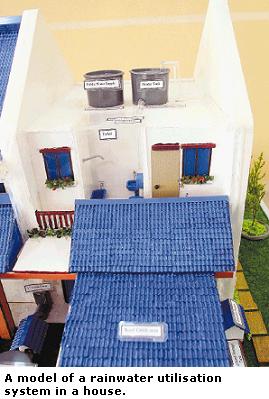Rainwater down the drain instead of flushing toilets
03/03/2007 By Sonia Ramachandran
PETALING JAYA: Itís an irony that has irked water experts for
years: millions spent on treating water, only to flush it down the toilet
again.
The alternative, at least where water for the toilet and other purposes
besides consumption is concerned, would cost just between RM2,500 and
RM5,000.
 But the key players in
the matter ó housing developers ó are unwilling to cover the cost of
installing rainwater harvesting (RWH) equipment in new houses. But the key players in
the matter ó housing developers ó are unwilling to cover the cost of
installing rainwater harvesting (RWH) equipment in new houses.
Their reluctance has put paid to government efforts to encourage Malaysians
to depend less on piped water and more on harvested rainwater.
RWH came into the picture for the first time in 1999 with guidelines drawn
up on how the people could go about it.
The guidelines were included in the Storm Water Management System manual in
2000 as a secondary objective besides combating floods.
Housing and Local Government Ministry statistics show a dismal response from
housing developers to RWH: None of the 169,960 housing developments approved
in 2005 had it.
Federation of Malaysian Consumers Associations (Fomca) environment manager
Loga Sunthri Veeraiah said it was useless to ask the public to conserve
water when they were not given the tools to do so.
She said RWH was a tool that should be actively introduced in Malaysia.
"The weather patterns here are conducive to RWH. We just had floods. We also
have a good monsoon season followed by a dry season. Using RWH, you can
collect water when it rains and use it when there is a drought," she said.
She said Malaysians had just not got down to taking the "Guidelines for
Installing Rain Water Collection and Utilisation" seriously.
"India and Australia have used it successfully. In Bangalore, itís even been
turned into a by-law," she said.
Loga said a developerís cost of installing RWH would only be one per cent of
the total housing development cost.
"This water is not for consumption. Itís only to be used in toilet flushing
and in the garage and garden and for general washing."
Consumers, she said, would not be willing to practise RWH on their own
because of the cost factor.
She said housing developers were reluctant to install RWH as it was purely
voluntary at the moment.
Loga said the government should promote RWH by explaining the cost benefits
to the public.
Fomca, she said, wanted the guidelines incorporated into the Water Services
Industry Act 2005 to give it teeth.
Real Estate and Housing Developersí Association of Malaysia (Rehda)
president Ng Seing Liong said RWH should not be encouraged as the country
had abundant water resources.
"The country has a lot of water. Itís just the management of it that is the
problem," he said.
Ng said developers balked at the cost of RWH as the cost of installation
would have to be passed on to the consumer.
Meanwhile, Drainage and Irrigation Department director-general Datuk Dr
Keizrul Abdullah said the government was actively trying to encourage
housing developers to incorporate RWH in projects.
"It can be cheap and if incorporated into the house design, can be
aesthetic, too," he said.
Keizrul said that during the 1997 El Nino, one major problem faced was
carrying water up to apartments to flush toilets. Thatís when the idea to
flush toilets using harvested rainfall was mooted.
Keizrul said many individuals had installed the rainfall harvesting system
on their own after they went through water rationing during the drought. |